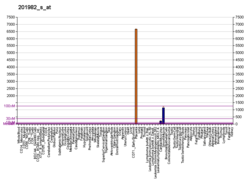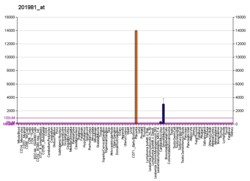Pregnancy-associated plasma protein A
Pappalysin-1, also known as pregnancy-associated plasma protein A, is a protein encoded by the PAPPA gene in humans. PAPPA is a secreted protease whose main substrate is insulin-like growth factor binding proteins. Pappalysin-1 is also used in screening tests for Down syndrome.[5][6]
Function
This gene encodes a secreted metalloproteinase which cleaves insulin-like growth factor binding proteins (IGFBPs). PAPPA's proteolytic function is activated upon collagen binding. It is thought to be involved in local proliferative processes such as wound healing and bone remodeling. Low plasma level of this protein has been suggested as a biochemical marker for pregnancies with aneuploid fetuses (fetuses with an abnormal number of chromosomes).[6] For example, low PAPPA may be commonly seen in prenatal screening for Down syndrome.[5] Low levels may alternatively predict issues with the placenta, resulting in adverse complications such as intrauterine growth restriction, preeclampsia, placental abruption, premature birth, or fetal death.
Interactions
Pregnancy-associated plasma protein A has been shown to interact with major basic protein.[7][8][9]
References
- GRCh38: Ensembl release 89: ENSG00000182752 - Ensembl, May 2017
- GRCm38: Ensembl release 89: ENSMUSG00000028370 - Ensembl, May 2017
- "Human PubMed Reference:". National Center for Biotechnology Information, U.S. National Library of Medicine.
- "Mouse PubMed Reference:". National Center for Biotechnology Information, U.S. National Library of Medicine.
- Breathnach FM, Malone FD (2007). "Screening for aneuploidy in first and second trimesters: is there an optimal paradigm?". Curr. Opin. Obstet. Gynecol. 19 (2): 176–82. doi:10.1097/GCO.0b013e3280895e00. PMID 17353686.
- "Entrez Gene: PAPPA pregnancy-associated plasma protein A, pappalysin 1".
- Overgaard MT, Haaning J, Boldt HB, Olsen IM, Laursen LS, Christiansen M, Gleich GJ, Sottrup-Jensen L, Conover CA, Oxvig C (October 2000). "Expression of recombinant human pregnancy-associated plasma protein-A and identification of the proform of eosinophil major basic protein as its physiological inhibitor". J. Biol. Chem. 275 (40): 31128–33. doi:10.1074/jbc.M001384200. PMID 10913121.
- Overgaard MT, Sorensen ES, Stachowiak D, Boldt HB, Kristensen L, Sottrup-Jensen L, Oxvig C (January 2003). "Complex of pregnancy-associated plasma protein-A and the proform of eosinophil major basic protein. Disulfide structure and carbohydrate attachment". J. Biol. Chem. 278 (4): 2106–17. doi:10.1074/jbc.M208777200. PMID 12421832.
- Oxvig C, Sand O, Kristensen T, Gleich GJ, Sottrup-Jensen L (June 1993). "Circulating human pregnancy-associated plasma protein-A is disulfide-bridged to the proform of eosinophil major basic protein". J. Biol. Chem. 268 (17): 12243–6. PMID 7685339.
Further reading
- Sinosich MJ, Zakher A (1992). "Pregnancy-associated plasma protein A interaction with heparin: a critical appraisal". Gynecol. Obstet. Invest. 32 (2): 72–7. doi:10.1159/000292998. PMID 1721035.
- Bischof P, Tseng L (1986). "In vitro release of pregnancy-associated plasma protein-A (PAPP-A) by human endometrial cells". American Journal of Reproductive Immunology and Microbiology : AJRIM. 10 (4): 139–42. doi:10.1111/j.1600-0897.1986.tb00013.x. PMID 2422961.
- Bolton AE, Pinto-Furtado LG, Andrew CE, Chapman MG (1986). "Measurement of the pregnancy-associated proteins, placental protein 14 and pregnancy-associated plasma protein A in human seminal plasma". Clinical Reproduction and Fertility. 4 (3): 233–40. PMID 2427179.
- Sinosich MJ, Saunders DM (1987). "Potential role of pregnancy-associated plasma protein-A in human reproduction". J. Reprod. Immunol. 10 (1): 55–65. doi:10.1016/0165-0378(87)90050-7. PMID 2438405.
- Tornehave D, Chemnitz J, Teisner B, et al. (1985). "Immunohistochemical demonstration of pregnancy-associated plasma protein A (PAPP-A) in the syncytiotrophoblast of the normal placenta at different gestational ages". Placenta. 5 (5): 427–31. doi:10.1016/S0143-4004(84)80023-5. PMID 6084247.
- McIntyre JA, Hsi B, Faulk WP, et al. (1982). "Immunological studies of the human placenta: functional and morphological analysis of pregnancy-associated plasma protein A (PAPP-A)". Immunology. 44 (3): 577–83. PMC 1554973. PMID 6172371.
- Bischof P, Geinoz A, Herrmann WL, Sizonenko PC (1984). "Pregnancy-associated plasma protein A (PAPP-A) specifically inhibits the third component of human complement (C3)". Placenta. 5 (1): 1–7. doi:10.1016/S0143-4004(84)80044-2. PMID 6203109.
- Schindler AM, Bischof P (1984). "Histochemical localization of pregnancy-associated plasma protein A in fetal, infant, and adult organs and comparison between antisera". Gynecol. Obstet. Invest. 18 (2): 88–94. doi:10.1159/000299055. PMID 6207082.
- Kristensen T, Oxvig C, Sand O, et al. (1994). "Amino acid sequence of human pregnancy-associated plasma protein-A derived from cloned cDNA". Biochemistry. 33 (6): 1592–8. doi:10.1021/bi00172a040. PMID 7508748.
- Durham SK, Kiefer MC, Riggs BL, Conover CA (1994). "Regulation of insulin-like growth factor binding protein 4 by a specific insulin-like growth factor binding protein 4 proteinase in normal human osteoblast-like cells: implications in bone cell physiology". J. Bone Miner. Res. 9 (1): 111–7. doi:10.1002/jbmr.5650090115. PMID 7512304.
- Bonno M, Oxvig C, Kephart GM, et al. (1994). "Localization of pregnancy-associated plasma protein-A and colocalization of pregnancy-associated plasma protein-A messenger ribonucleic acid and eosinophil granule major basic protein messenger ribonucleic acid in placenta". Lab. Invest. 71 (4): 560–6. PMID 7526035.
- Oxvig C, Haaning J, Kristensen L, et al. (1995). "Identification of angiotensinogen and complement C3dg as novel proteins binding the proform of eosinophil major basic protein in human pregnancy serum and plasma". J. Biol. Chem. 270 (23): 13645–51. doi:10.1074/jbc.270.23.13645. PMID 7539791.
- Zorin NA, Zhabin SG, Semenkov NN (1995). "Interaction of human pregnancy-associated plasma protein-A with serine proteinases". Clin. Chim. Acta. 239 (1): 47–55. doi:10.1016/0009-8981(95)06098-X. PMID 7586586.
- Silahtaroglu AN, Tümer Z, Kristensen T, et al. (1993). "Assignment of the human gene for pregnancy-associated plasma protein A (PAPPA) to 9q33.1 by fluorescence in situ hybridization to mitotic and meiotic chromosomes". Cytogenet. Cell Genet. 62 (4): 214–6. doi:10.1159/000133479. PMID 7679961.
- Oxvig C, Sand O, Kristensen T, et al. (1993). "Circulating human pregnancy-associated plasma protein-A is disulfide-bridged to the proform of eosinophil major basic protein". J. Biol. Chem. 268 (17): 12243–6. PMID 7685339.
- Haaning J, Oxvig C, Overgaard MT, et al. (1996). "Complete cDNA sequence of the preproform of human pregnancy-associated plasma protein-A. Evidence for expression in the brain and induction by cAMP". Eur. J. Biochem. 237 (1): 159–63. doi:10.1111/j.1432-1033.1996.0159n.x. PMID 8620868.
- Lawrence JB, Oxvig C, Overgaard MT, et al. (1999). "The insulin-like growth factor (IGF)-dependent IGF binding protein-4 protease secreted by human fibroblasts is pregnancy-associated plasma protein-A". Proc. Natl. Acad. Sci. U.S.A. 96 (6): 3149–53. doi:10.1073/pnas.96.6.3149. PMC 15910. PMID 10077652.
- Overgaard MT, Oxvig C, Christiansen M, et al. (1999). "Messenger ribonucleic acid levels of pregnancy-associated plasma protein-A and the proform of eosinophil major basic protein: expression in human reproductive and nonreproductive tissues". Biol. Reprod. 61 (4): 1083–9. doi:10.1095/biolreprod61.4.1083. PMID 10491647.
- Overgaard MT, Haaning J, Boldt HB, et al. (2000). "Expression of recombinant human pregnancy-associated plasma protein-A and identification of the proform of eosinophil major basic protein as its physiological inhibitor". J. Biol. Chem. 275 (40): 31128–33. doi:10.1074/jbc.M001384200. PMID 10913121.
- Hourvitz A, Widger AE, Filho FL, et al. (2001). "Pregnancy-associated plasma protein-A gene expression in human ovaries is restricted to healthy follicles and corpora lutea". J. Clin. Endocrinol. Metab. 85 (12): 4916–20. doi:10.1210/jc.85.12.4916. PMID 11134163.





